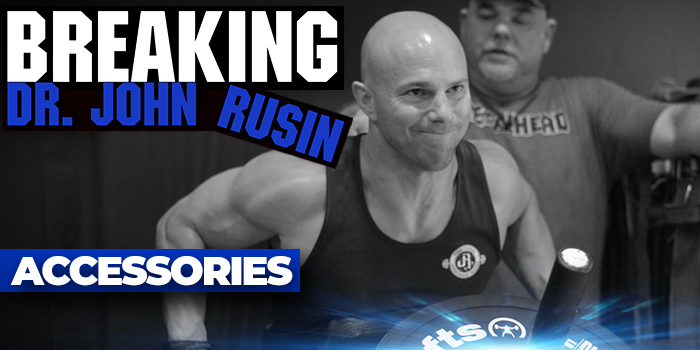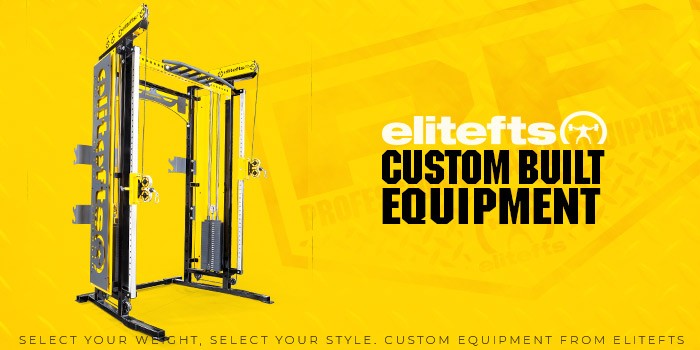
Dr. John Rusin has been working closely with Dave Tate to flip the script on the Fixing Dave Tate Series that kicked off earlier this year. In this twist on the original series, it is now Tate who is coaching Rusin in an effort to accelerate his progress on the three main accessory lifts. Together, they broke down his technique with regard to the squat, bench press, and deadlift in a series of one-on-one coaching sessions that revealed key areas for improvement. They also sat down together to chart out a comprehensive training program for Rusin that would incorporate learnings from across the series.
Tate and Rusin team up once again, this time to address accessory movements. From chest-supported rows, to vertical pull-downs and face-pulls, Tate tightens up Rusin’s supporting exercises to ensure that they are addressing his weak points in a way that will have correspondence to the “big three” lifts. Throughout the session, Tate reiterates the importance of purpose and application – every exercise has to have a reason. This is the only way that powerlifters and athletes will see consistent, sustainable gains over time.
Chest-Supported Rows
They start off the session with rows. However, as Tate explains, these particular rows are going to be performed with the elbows out, as opposed to down. This helps to pull the back together and down, a similar sensation to the bench press (including a static hold at the top). Tate is a fan of chest-supported rows – even more so than a seated row that’s chest-supported – because they isolate the work to the upper back. The lower back was straining while benching and arching, and is thus already more taxed than Rusin might initially think. As such, it’s not necessary for the lower back to take on any type of blunt force in this movement.
For those that don’t have a chest-supported row available to them, just use a bench and prop it up on a plate. As Tate mentions, he does like the idea of it being a barbell, because that allows for some level of correspondence to the barbell. Dumbbells fit another role, but when it comes to the bench press, simulating that as much as possible is a good thing.
Same Exercise, Different Application
As an aside, Tate acknowledges that this kind of row is not a movement that he would recommend to someone that is training specifically for muscle hypertrophy. In fact, when Rusin would bring groups of bodybuilders out to train, these were the kinds of rows that they were (mistakenly) performing. In the end, it was why their lats weren’t growing – they essentially had huge traps and huge rear deltoids, but lacked the lat activation. As such, this is where one exercise can have very different applications, depending on the overall goal. As Tate puts it:
That’s why there’s no good or bad exercise – it’s the application of the exercise, and what it’s for.
To illustrate his point, Tate gestures to Rusin’s back, indicating that there seems to be a bit of a “hole” in his back muscles between his shoulder blades. For a powerlifter, ideally there should almost be a hump of muscle visible there, as you would see with trap build-up. For a bodybuilder, however, ideal build-up is in a slightly lower place on the back. In other words, going “high” leads to a more stabilized bench, and going “low” leads to lat muscle growth. For Rusin, the focus is on the upper back, between the shoulder-blades, because this helps to stabilize the bench (as well as the squat and deadlift). When he pulls, he must focus on bringing the top of his shoulder blades together. Tate states that both approaches have their own application, and Rusin may choose to put both into his program, but when it comes to stabilizing the bench (a weak point for Rusin), he should focus on his shoulder blades.
Vertical Pull-Downs
Tate does like to incorporate vertical pulling of some sort as part of accessory work (though usually on a different day than horizontal pulling). He adds that he doesn’t push a high volume on this kind of exercise, both because he believes that it doesn’t have a lot of carryover for powerlifters in particular, and also because it has high risk. Furthermore, because Rusin is running more of a balanced type of program, there is not a lot to balance out this movement – and he naturally, Tate wants to avoid creating some kind of imbalance.
To further explain, Tate says that when he is dealing with intermediate-advanced athletes or lifters, they typically don’t require a lot of volume; their workload is higher and their weights are heavier. When it comes to beginners, however, they may need ten or twelve exercises just to get enough work in during their session. In other words, the stronger someone becomes, the more their volume comes down because their workload increases. Additionally, advanced athletes are more quickly fatigued because of proper neuro-synchronizing. Beginners simply aren’t generating as much force as someone who is explosive and efficient at a given movement.
Face-Pulls
Rusin moves on to face-pulls, which are incorporated into his accessory work as another means to address the weak point in his back. He is performing the movement with open hands; Tate explains that this helps to take the grip and forearm out of the equation, thereby isolating focus into his upper back.
According to Tate, powerlifters should always be able to justify every movement in their training program, as well as the rationale for why they are performing it a certain way. In his opinion, if it’s an accessory movement that can be done more efficiently with a lighter weight, so be it. All of this feeds into Tate’s philosophy that every component of training is intentional, and should serve a specific purpose when corresponding to a powerlifter’s overall performance.
Every exercise has to have a reason – if it doesn’t have a reason, I don’t want to see it, unless its during free time. And then the way that you do the exercise has to have a reason. If you can’t [justify it], then don’t do it.









